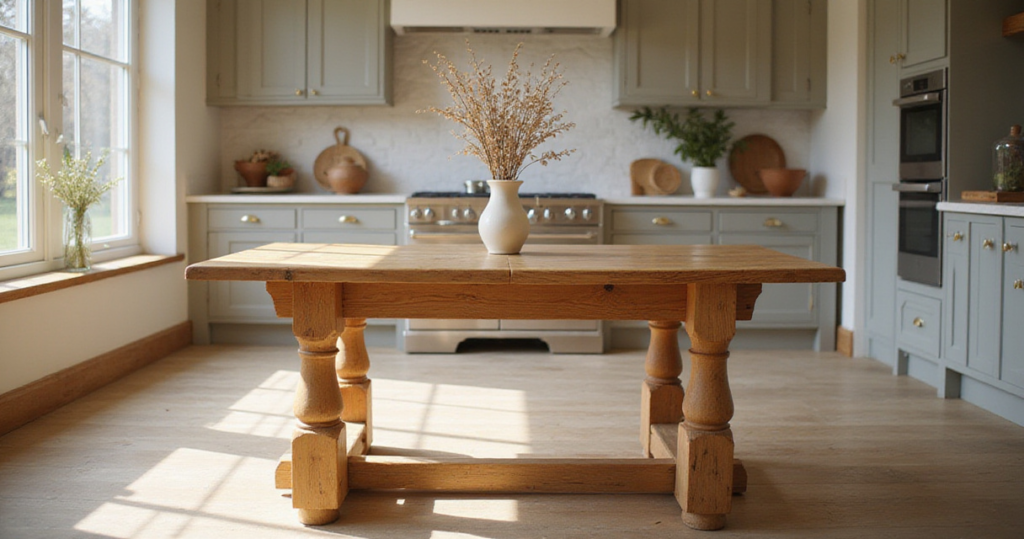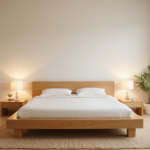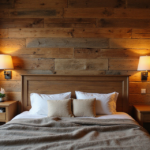When you’re living in a small space, every piece of furniture needs to earn its place through both function and style. Your kitchen table isn’t just where you eat—it’s your workspace, homework station, craft corner, and gathering spot all rolled into one. That’s why choosing the right farmhouse kitchen table becomes even more critical when square footage is at a premium.
I’ve spent years helping apartment dwellers and small-space owners maximize their homes’ potential, and I’ve learned that the right table can completely transform how a compact kitchen functions. A farmhouse kitchen table brings warmth and character to even the tiniest spaces while providing the durability needed for multi-purpose living. But finding one that fits your space, budget, and lifestyle requires strategy.
The challenge isn’t just picking something that looks good—it’s finding a piece that can handle your morning coffee, afternoon work calls, evening family dinners, and weekend projects without overwhelming your space or breaking your budget. From studio apartments to cozy condos, I’ve seen how the right farmhouse kitchen table becomes the anchor that makes small spaces feel like home.
These 18 essential tips will guide you through every aspect of choosing, styling, and maintaining your farmhouse kitchen table, with special attention to the unique considerations that come with smaller living spaces. Let’s dive in and find the perfect table that will serve as the hardworking heart of your home.
1. Set a Realistic Budget for Your Farmhouse Table
Before you fall in love with that gorgeous reclaimed wood table online, establishing a clear budget framework prevents both financial strain and hours of browsing pieces outside your price range. In small spaces where every purchase matters more, knowing your spending limit helps you focus on tables that deliver maximum value per square foot they occupy.
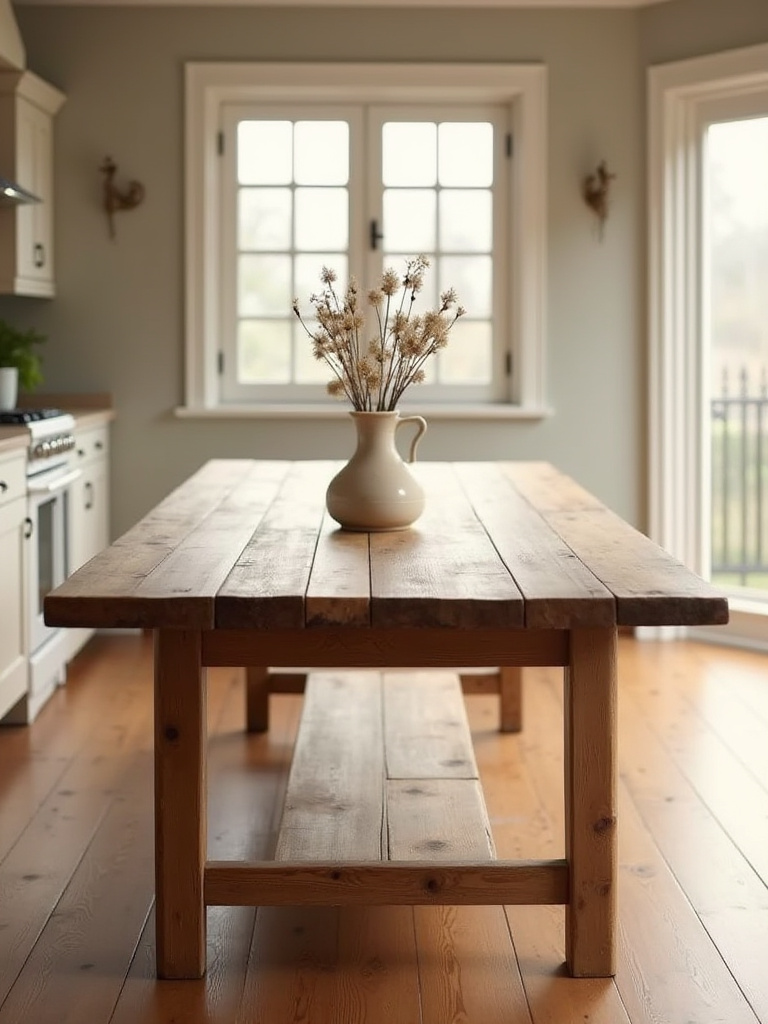
Setting a realistic budget means looking beyond the sticker price to factor in delivery fees (which can range from $50 to $500 depending on size and distance), potential assembly costs, and any refinishing needs for secondhand pieces. For small-space dwellers, I typically recommend allocating 60-70% of your budget to the table itself and reserving the remainder for these additional costs. Entry-level solid wood tables start around $400-800, mid-range options fall between $800-2,000, while custom pieces can exceed $2,500. Remember that in a compact kitchen, your table will likely see heavier daily use than in larger homes, making quality construction worth the investment.
Research typical sale cycles for furniture retailers—major holidays and end-of-season clearances often yield 30-40% savings on quality pieces. For custom work, always request detailed quotes that break down materials, labor, and delivery costs upfront to avoid surprises.
With your budget firmly established, the next critical decision involves ensuring your chosen table actually fits your space—both physically and functionally.
2. Select the Perfect Farmhouse Table Size for Your Space
In small-space living, getting the size wrong isn’t just inconvenient—it can make your entire kitchen feel cramped and dysfunctional. I’ve seen too many clients squeeze oversized tables into compact spaces, only to find themselves constantly bumping into chairs or struggling to access cabinets. The right size creates flow and makes your space feel larger, not smaller.
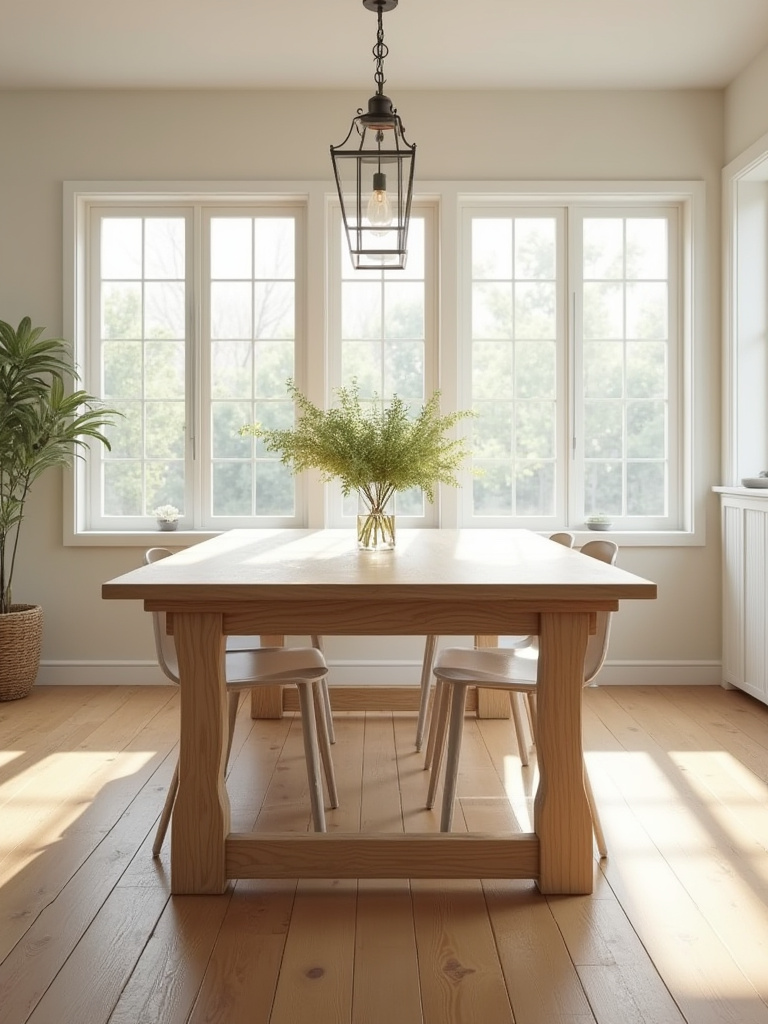
Start by measuring your available space and subtracting 36-48 inches on all sides where people need to walk or pull out chairs. This clearance is non-negotiable for comfortable living. A 6-foot rectangular table seats six people but needs roughly 10 feet by 8 feet of total floor space when you account for chair movement. For tight spaces, consider a 48-inch round table, which seats four comfortably and requires less clearance than rectangular options due to its lack of corners.
Use painter’s tape to mark your table’s footprint on the floor, including chair space, before making any purchase. This simple trick has saved countless clients from costly mistakes. Remember that your table will likely serve multiple functions in a small space, so ensure the size works for both dining and your other daily activities like working from home or crafting projects.
Once you’ve determined the maximum size that works, the shape you choose can further optimize your space’s functionality and flow.
3. Decide Which Farmhouse Table Shape Fits Your Room Best
The shape of your farmhouse kitchen table dramatically affects how your small space functions and feels. Round tables eliminate sharp corners that can catch clothing or bruise hips in tight quarters, while rectangular tables maximize seating capacity when space allows. The wrong shape can create bottlenecks and dead zones that make your kitchen feel even smaller.
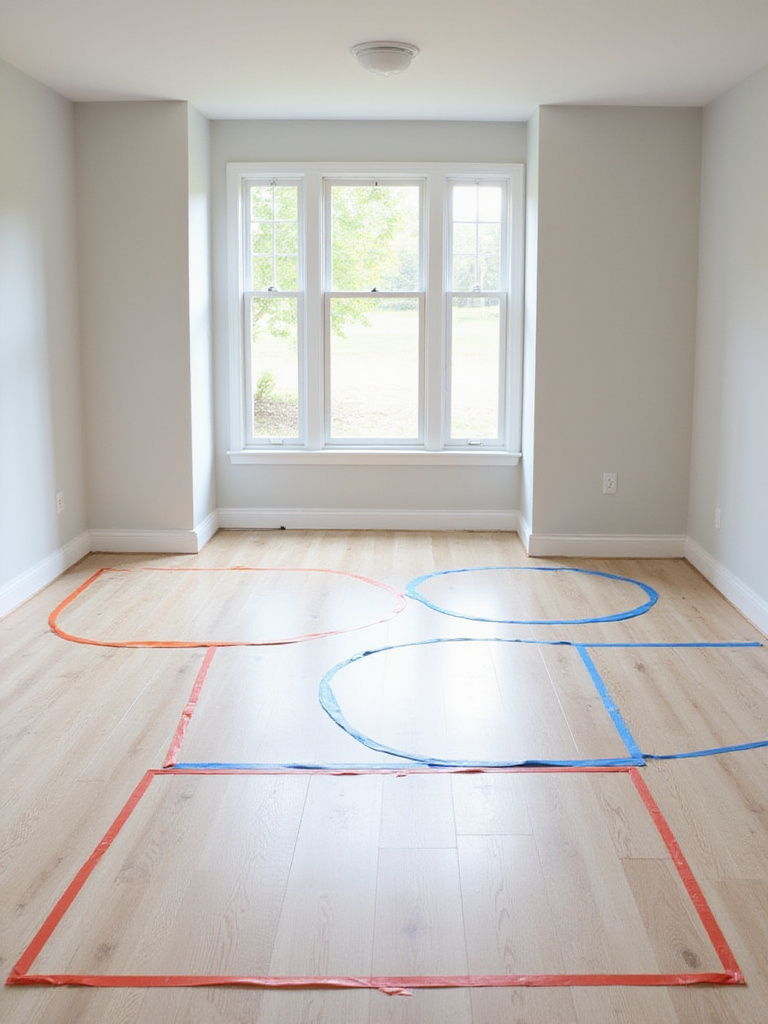
Rectangular tables work best in longer, narrower spaces and provide maximum surface area for both dining and work activities. They’re ideal if you frequently need workspace for projects or often host larger groups. Round tables excel in square spaces and promote better conversation flow since everyone sits equidistant from each other. They also allow for more flexible chair placement—you can easily squeeze in an extra person when needed.
For extremely tight spaces, consider oval tables, which offer the space efficiency of round tables with slightly more surface area. Pedestal bases work better than four-leg designs in small spaces since they eliminate corner obstructions and provide more legroom. Test different shapes using cardboard templates or tape outlines on your floor to visualize how each option affects traffic patterns and daily movement through your kitchen.
Beyond size and shape, the material your table is made from determines how well it will withstand the heavy daily use that comes with small-space living.
4. Understand Farmhouse Table Wood Types and Durability
When your kitchen table serves as dining surface, desk, craft station, and homework hub all in one day, material choice becomes critical. In small spaces, furniture works harder, so understanding wood types and their durability ratings helps ensure your investment withstands years of multi-purpose use without showing excessive wear.
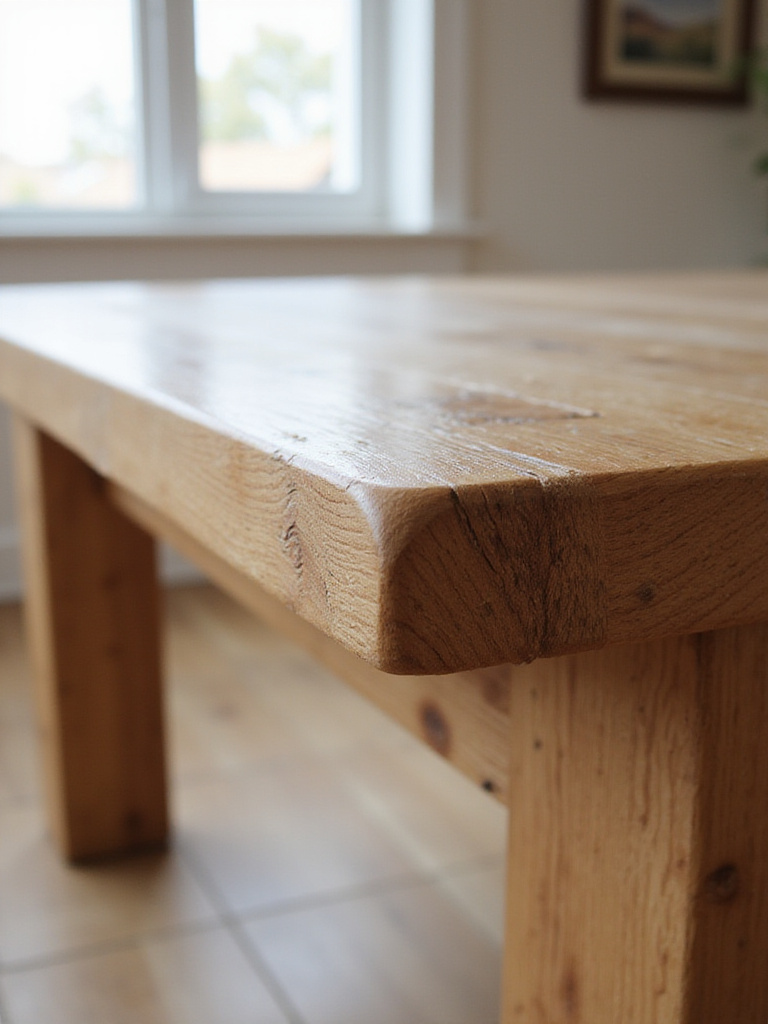
Hardwoods like oak (Janka rating: 1290), maple (1450), and cherry (995) resist dents and scratches far better than softwoods like pine (380). While pine offers authentic farmhouse character at lower prices, it will show every coffee mug set down without a coaster and every craft project mishap. For small-space dwellers who use their table heavily, investing in harder woods pays off through reduced maintenance and longer lifespan.
Consider your household’s activity level when choosing materials. Families with children or those who frequently work from the table should prioritize woods with Janka ratings above 1000. If you love the look of softer woods, look for thicker tops (1.5-2 inches) or consider reclaimed lumber, which has often hardened with age. The grain pattern also matters—tight grains like maple hide minor scratches better than open grains like oak, though oak’s natural texture can camouflage everyday wear.
The foundation that supports your tabletop is equally important, and choosing between different base styles affects both stability and functionality in your space.
5. Compare Farmhouse Table Bases: Trestle vs. Pedestal Styles
The base style of your farmhouse kitchen table affects more than just aesthetics—it determines seating flexibility, legroom, and visual weight in your space. In smaller kitchens where every inch matters, the right base can make the difference between a table that enhances your space and one that overwhelms it.
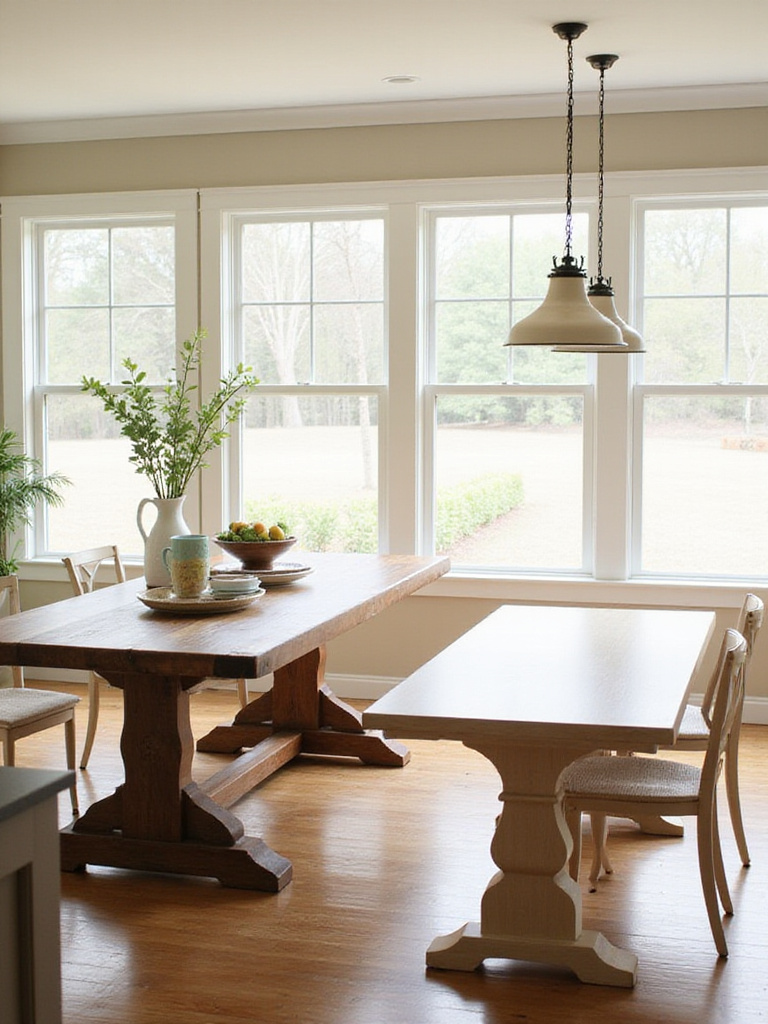
Pedestal bases offer maximum seating flexibility since there are no corner legs to navigate around. This design typically allows you to fit 2-4 more people around the same size table compared to traditional four-leg designs. The single central support also provides unobstructed legroom, making it easier for people to sit down and get up—crucial in tight spaces where chairs can’t be pulled far from the table. However, ensure the pedestal base is substantial enough for your tabletop size; tables over 6 feet typically need double pedestals or very wide single bases for stability.
Trestle bases provide superior stability for large, heavy tabletops and create a strong visual anchor in your space. The horizontal stretcher adds structural integrity but can limit legroom for taller individuals. Check that the stretcher height allows comfortable leg positioning—it should be at least 24 inches from the floor. Trestle bases tend to have a more traditional farmhouse appearance and work well in spaces where you want the table to feel substantial and grounded rather than light and airy.
With your table selected, the seating you pair with it can significantly impact both the functionality and style of your small dining area.
6. Pair the Ideal Chairs and Benches with Your Table
Seating choices make or break the functionality of your farmhouse kitchen table, especially in small spaces where flexibility and efficiency are paramount. The right combination of chairs and benches can increase your seating capacity by 20-30% while maintaining the relaxed, welcoming aesthetic that defines farmhouse style.
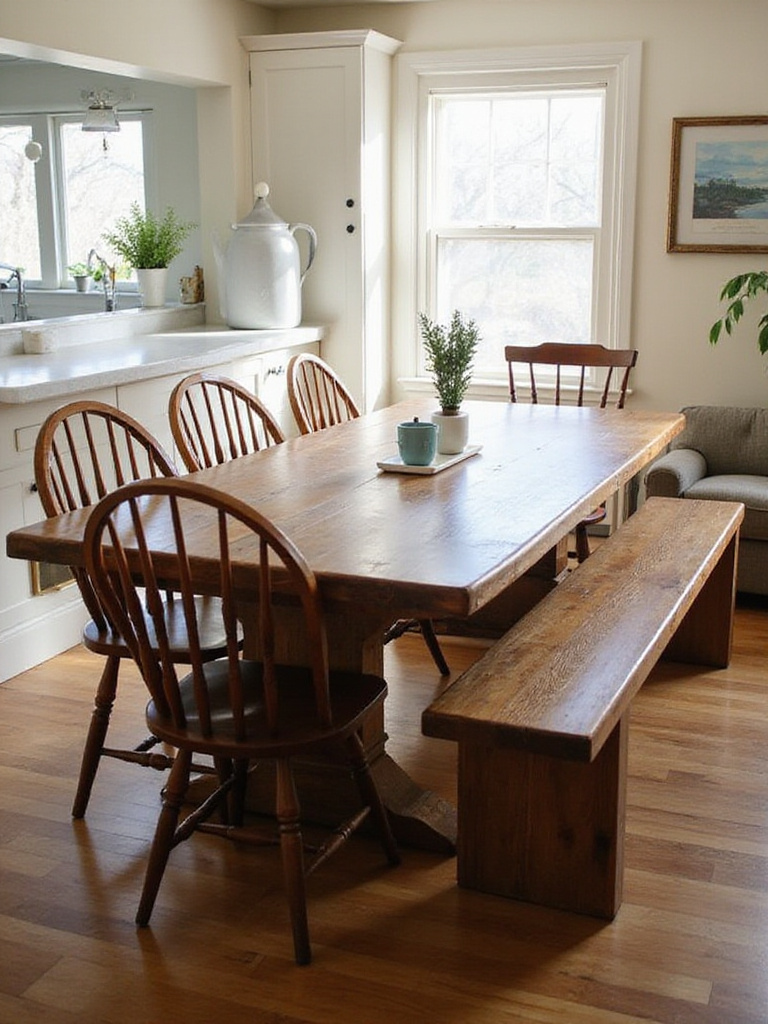
Mixing seating types adds visual interest and practical benefits. A bench along one side of your table can seat three people in the space that two chairs would occupy, while chairs on the opposite side provide structured seating for adults. Benches also tuck completely under the table when not in use, freeing up valuable floor space in compact kitchens. Ensure your seating height works with your table—chair seats should be 10-12 inches below the tabletop for comfortable dining.
Consider stackable or nesting chairs if you occasionally need extra seating but lack storage space. Stools work well for casual meals and can double as extra surface space when needed. For small spaces, avoid chairs with arms, which take up more room and can’t be pushed as close to the table. Mix materials thoughtfully—wooden benches with metal chairs, or upholstered seats with painted wooden backs—to create the layered, collected-over-time look that makes farmhouse style feel authentic rather than matched set.
The placement of your table within your kitchen or dining area is just as crucial as the table itself for creating an efficient, comfortable space.
7. Find the Best Spot and Layout for Your Table
Strategic placement transforms a good farmhouse kitchen table into the perfect centerpiece for your small space. Poor positioning can create traffic bottlenecks, block natural light, or make your kitchen feel cramped, while thoughtful placement enhances flow and makes the entire area more functional and inviting.
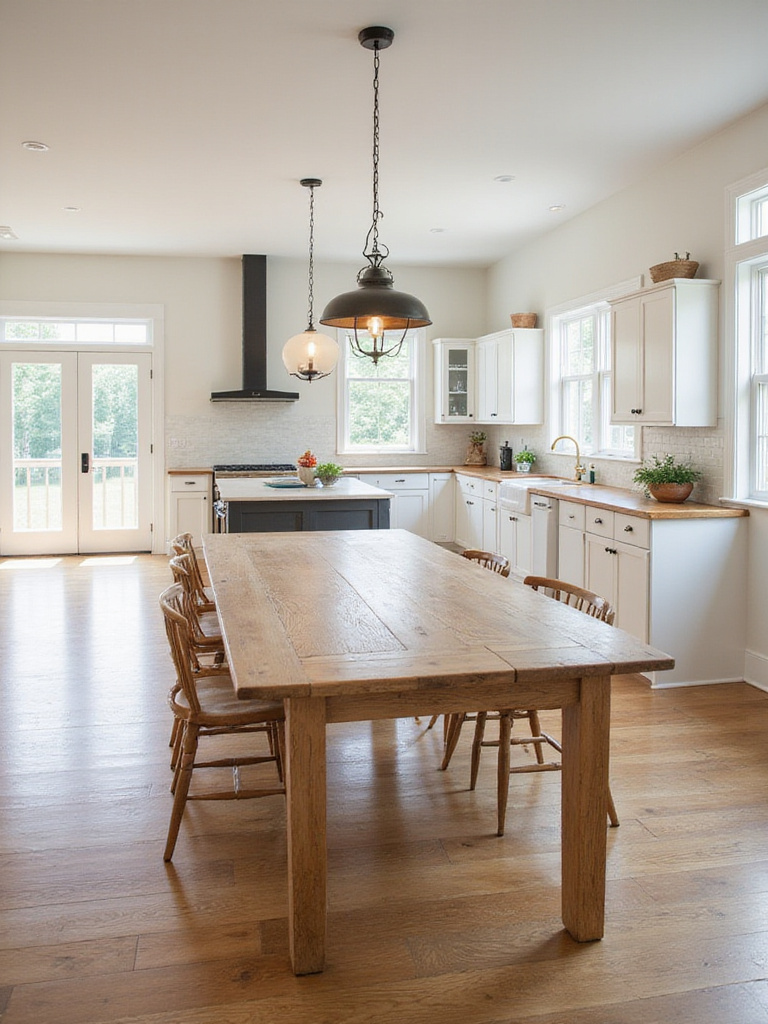
Consider your kitchen’s work triangle—the path between sink, stove, and refrigerator—and ensure your table doesn’t interfere with cooking activities. Position the table to benefit from natural light during daytime meals, but avoid blocking windows that provide essential illumination for food preparation. In open-plan spaces, use your table’s placement to create visual separation between cooking and dining zones without building walls.
Maintain at least 36 inches of clearance around the table where people need to walk, with 42-48 inches being ideal in high-traffic areas. In galley kitchens, consider placing a narrow rectangular table against one wall with bench seating to maximize walking space. For studio apartments, position your table to serve as a subtle room divider between living and sleeping areas. Use area rugs or pendant lighting to define the dining zone and create visual boundaries in open spaces.
Proper lighting above your table creates ambiance and functionality, turning your dining area into a true focal point of your home.
8. Choose the Perfect Pendant Light for Above Your Table
The right pendant light transforms your farmhouse kitchen table from a simple surface into a defined, intimate gathering space. In small homes where the dining area often shares space with the kitchen or living room, pendant lighting creates visual boundaries and establishes the table as a distinct zone for meals and activities.
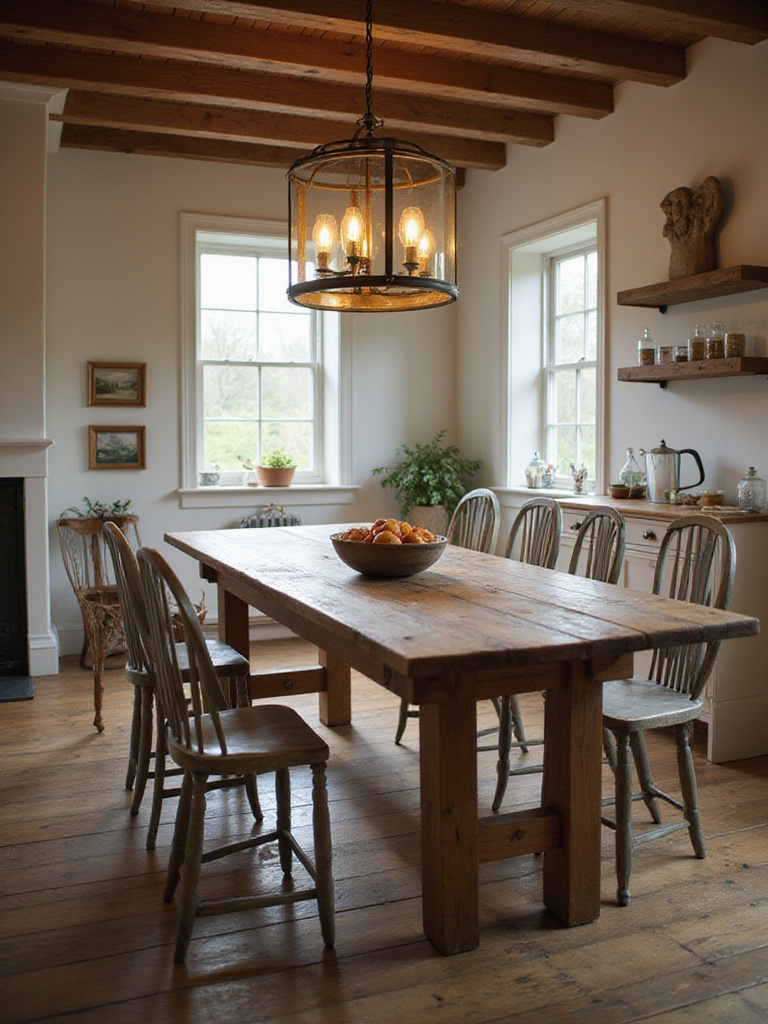
Scale your pendant to your table size—a fixture that’s too small disappears above a substantial farmhouse table, while an oversized pendant can overwhelm a compact space. For tables up to 6 feet, one large pendant works well. Longer tables benefit from two or three smaller pendants spaced evenly for balanced illumination. Hang the bottom of your fixture 30-36 inches above the tabletop to provide adequate task lighting without obstructing conversation across the table.
Choose fixtures that complement your farmhouse aesthetic while providing sufficient light for various activities. Industrial-style metal shades, rustic wood and iron lanterns, or simple glass globes all work well. Install dimmer switches to adjust lighting from bright task work to soft ambient dining. Consider the bulb type—warm LED bulbs (2700K-3000K) create the cozy atmosphere that makes farmhouse style so appealing. For small spaces, avoid fixtures that are too ornate or busy, which can make the area feel cluttered.
For maximum versatility in small spaces, consider tables that can expand when you need extra seating for guests or special occasions.
9. Add Seating Capacity with Table Leaves or Extensions
Expandable farmhouse kitchen tables offer crucial flexibility for small-space living, allowing you to accommodate varying numbers of people without permanently dedicating floor space to a larger table. This adaptability is essential when your dining area serves multiple functions and you occasionally need to host larger groups.
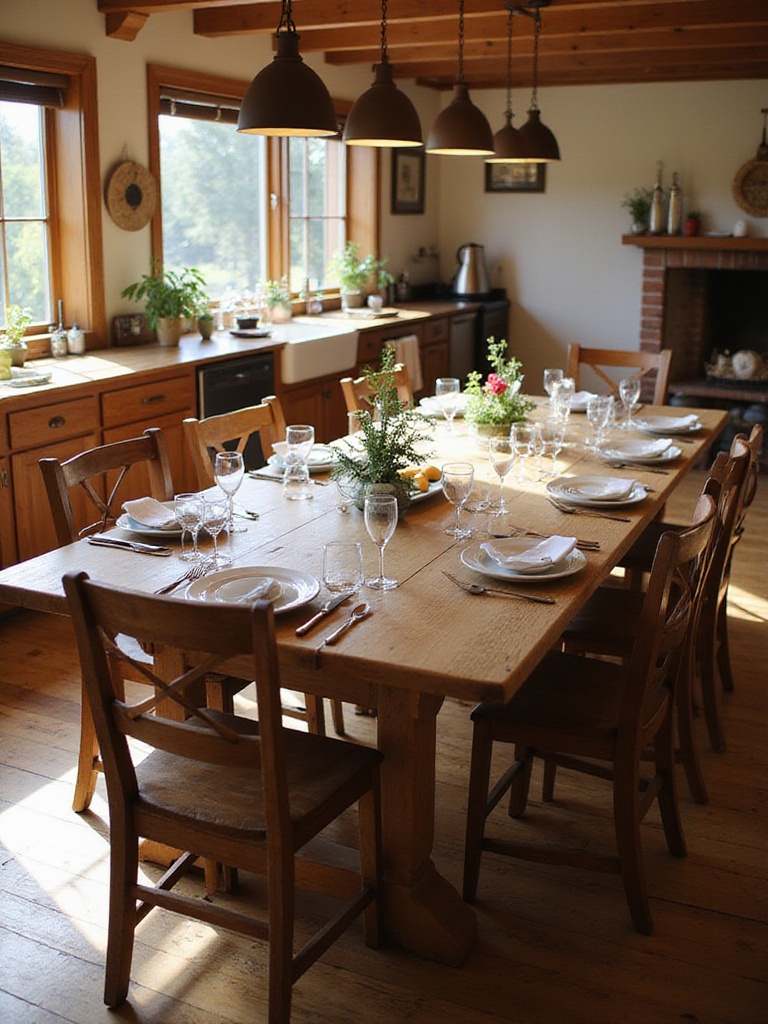
Extension mechanisms vary in convenience and storage requirements. Butterfly leaves fold and store within the table itself, making them ideal for small spaces with limited storage. Drop-leaf tables have sides that fold down, creating a very compact footprint for daily use. Traditional removable leaves require separate storage but often provide the most seamless expansion. Test the mechanism before purchasing—it should operate smoothly without requiring excessive force or multiple people.
Plan for leaf storage in advance. Butterfly leaves eliminate this concern, while removable leaves need protection from scratches and warping. Store leaves flat in a climate-controlled area, and insert them periodically to ensure consistent aging and color matching with the main table surface. A 48-inch round table with an 18-inch leaf can expand to seat eight people for holidays while maintaining a compact 4-person footprint for daily use—perfect for small spaces that occasionally need to accommodate larger gatherings.
For the ultimate space-saving solution, consider integrating your farmhouse table with built-in banquette seating.
10. Design a Cozy Farmhouse Table Banquette Nook
Creating a banquette nook with your farmhouse kitchen table maximizes seating capacity while minimizing floor space requirements—a perfect solution for small homes where every square foot counts. This built-in approach can increase your seating by 40-50% compared to traditional chair arrangements while adding valuable storage underneath.
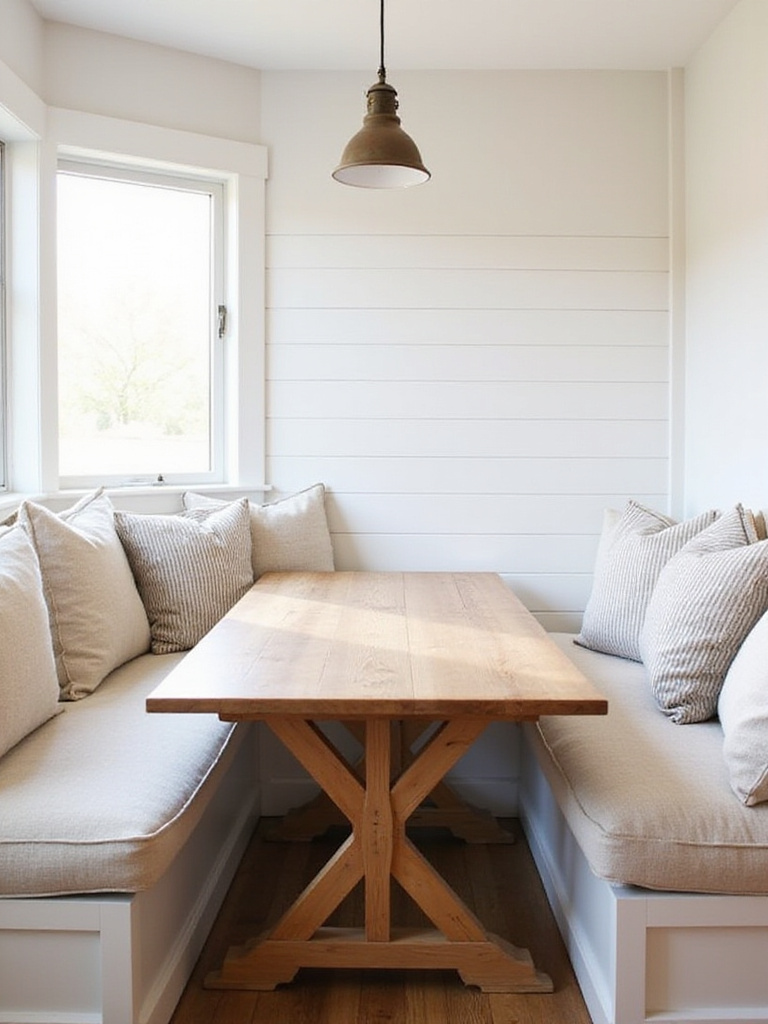
Design your banquette with standard dimensions: 18-inch seat depth, 18-inch height (including cushion), and 16-inch backrest height for optimal comfort. Choose a table with a pedestal or trestle base to allow easy sliding in and out of the banquette seating. Corner banquettes work particularly well in breakfast nooks or kitchen corners, transforming awkward spaces into cozy gathering spots that feel intentionally designed rather than squeezed in.
Incorporate storage drawers or lift-up seats in your banquette design to house table linens, seasonal items, or small appliances. Use performance fabrics for cushions that can withstand daily use and occasional spills. The fixed nature of banquette seating means you can position your table closer to walls and other furniture, reclaiming valuable floor space for movement and other activities. Add throw pillows in farmhouse patterns and textures to enhance comfort and style while maintaining the relaxed, welcoming atmosphere that defines this design approach.
The unexpected pairing that always works is maximizing your table’s potential by using it for activities beyond just dining.
11. Use Your Farmhouse Table Beyond Dining Functions
In small spaces, single-purpose furniture is a luxury you can’t afford. Your farmhouse kitchen table’s generous surface area and sturdy construction make it perfect for homework sessions, craft projects, laptop work, and board game nights. Embracing this versatility maximizes your investment and eliminates the need for additional furniture pieces that would crowd your space.
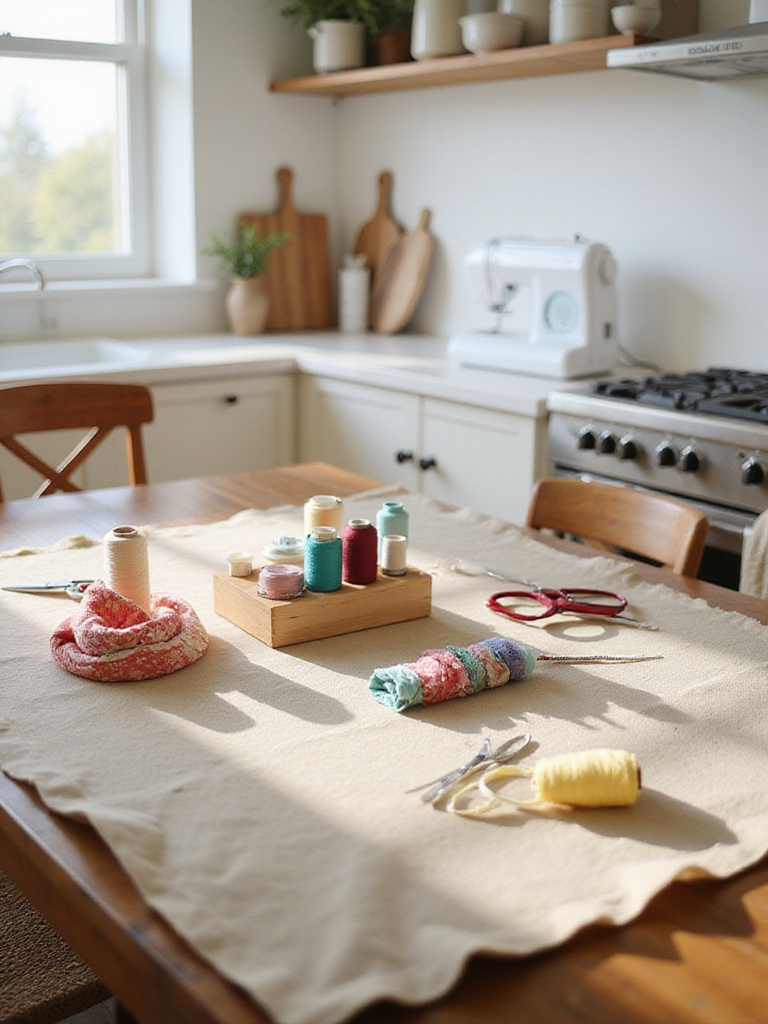
Establish clear routines for transitioning between functions. Keep portable organizers for different activities—a caddy for office supplies, a basket for craft materials, or a tray for homework essentials. This organization system allows quick setup and cleanup, maintaining the table’s primary dining function while supporting your varied needs. Use protective mats or tablecloths during messy activities to preserve the wood surface.
Create designated time blocks for different activities to maintain order and prevent the table from becoming a permanent dumping ground. Morning coffee and evening meals bookend the day, while afternoon hours might be reserved for work or children’s activities. The key is maintaining the table’s role as a gathering place while acknowledging the practical realities of small-space living where every surface must earn its keep through multiple functions.
When budget constraints are a concern, the secondhand market offers exceptional opportunities to find unique pieces with authentic character.
12. Score a Unique Farmhouse Table Buying Secondhand
Secondhand shopping opens doors to authentic farmhouse pieces with genuine history and character that new furniture simply cannot replicate. For small-space dwellers on tight budgets, this approach can deliver substantial savings—often 50-70% off retail prices—while providing access to solid wood construction that might otherwise be unaffordable.

Develop a clear search strategy across multiple platforms. Facebook Marketplace and Craigslist offer local options you can inspect before buying, while estate sales and antique shops provide curated selections with interesting provenance. Set up saved searches with specific keywords and size parameters to catch new listings quickly. Popular pieces move fast, so being prepared with measurements, budget, and transportation plans gives you an advantage.
Inspect thoroughly before purchasing. Check for structural soundness by testing for wobbles, examining joints for looseness, and looking for signs of pest damage or rot. Surface imperfections like scratches or water rings can often be addressed with refinishing, but structural issues may be costly to repair. Bring a small level to check for warping and a tape measure to confirm dimensions. Remember that patina and minor wear aren’t flaws—they’re part of the authentic character that makes secondhand pieces special.
The visual weight balances perfectly when you employ smart strategies to find quality pieces without overspending.
13. Find High-Quality Farmhouse Tables on a Budget
Quality doesn’t always correlate with price, especially when you know what to look for and where to shop. Smart budget strategies can help you secure a well-built farmhouse kitchen table that will serve your small space for decades without straining your finances or compromising on the durability needed for multi-purpose use.

Focus on construction quality over brand names or retail markups. Learn to identify solid wood versus veneer by checking edges and undersides—solid wood shows consistent grain throughout, while veneer reveals different wood or composite underneath. Look for traditional joinery like mortise and tenon or dovetail connections rather than simple screws and glue. These construction methods indicate furniture built to last, regardless of the price point.
Time your purchases strategically around retailer sale cycles. Major holidays, end-of-season clearances, and floor model sales can yield 30-50% savings on quality pieces. Consider unfinished furniture that you can stain or paint to match your aesthetic—this approach often provides solid wood construction at lower prices while allowing complete customization. Don’t overlook furniture outlets, warehouse stores, or even damaged freight dealers where cosmetic imperfections can translate to significant savings on structurally sound pieces.
Beyond aesthetics, the ecological impact matters because refinishing an existing table creates both environmental and financial benefits.
14. Give an Old Table New Life by Refinishing It
Refinishing transforms worn or outdated farmhouse tables into customized centerpieces perfectly suited to your space and style. This approach offers the dual benefits of environmental responsibility and significant cost savings—often 60-80% less than purchasing new—while allowing you to create exactly the finish and color that complements your small space’s aesthetic.

Start with proper preparation, which determines your final results more than any other factor. Strip old finish completely using chemical strippers for intricate details or progressive sanding for simpler surfaces. Begin with coarse grits (80-100) to remove old finish and progress through finer grits (220-320) for smoothness. Any remaining old finish will prevent new stain or topcoat from adhering properly, leading to blotchy or peeling results.
Choose finishes based on your table’s intended use. For heavy-duty kitchen tables that serve multiple functions, opt for durable polyurethane or conversion varnish that can withstand spills, heat, and daily wear. Water-based finishes dry faster and have less odor—important considerations in small spaces with limited ventilation. Apply thin, even coats and sand lightly between applications for professional results. The investment in quality materials and proper technique pays dividends in durability and appearance that rivals expensive new furniture.
The interplay between the colors creates opportunities to integrate farmhouse warmth into contemporary kitchen designs.
15. Seamlessly Blend Farmhouse Style into Modern Kitchens
Mixing farmhouse warmth with modern efficiency creates kitchens that feel both sophisticated and welcoming—perfect for small spaces that need to maximize both style and function. Your farmhouse kitchen table can serve as the bridge between these aesthetics, softening stark modern lines while maintaining the clean efficiency that makes small kitchens work.
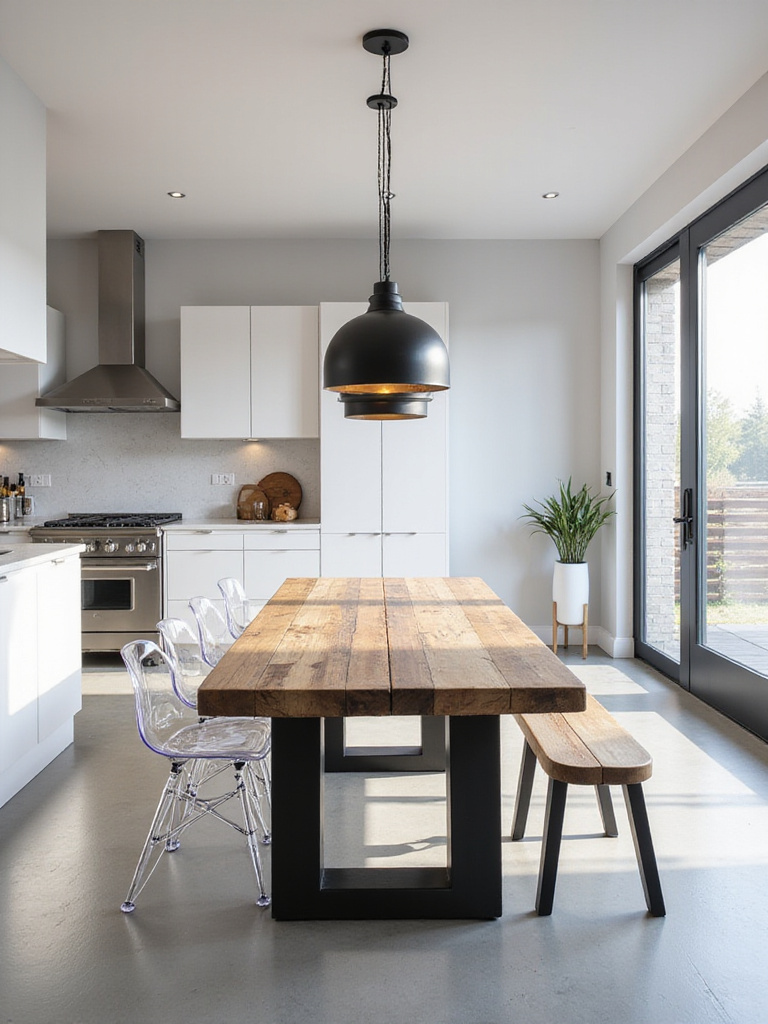
Choose tables with elements that speak to both styles. A reclaimed wood top with sleek metal legs combines farmhouse authenticity with modern materials. Painted bases in colors that match your cabinetry create visual continuity, while natural wood tops add warmth and texture. Keep the overall palette cohesive by limiting contrast—subtle variations work better in small spaces than dramatic juxtapositions that can feel chaotic.
Balance your materials and textures thoughtfully throughout the space. If your kitchen features smooth, contemporary surfaces, let your farmhouse table provide textural contrast through wood grain and traditional construction details. Pair the table with modern seating—clear acrylic chairs or sleek metal stools—to prevent the space from feeling too rustic. Use lighting and accessories to reinforce the blend: industrial pendants above a farmhouse table, or modern artwork alongside vintage-inspired textiles.
Running your hand across this material reveals why protecting your table’s surface is essential for maintaining its beauty and function.
16. Protect Your Tabletop from Scratches and Stains Easily
Daily protection prevents damage that’s far more expensive and time-consuming to repair than to prevent. In small spaces where your farmhouse kitchen table serves multiple functions—from dining surface to workspace to craft station—implementing simple protective measures preserves both its appearance and structural integrity for years of heavy use.
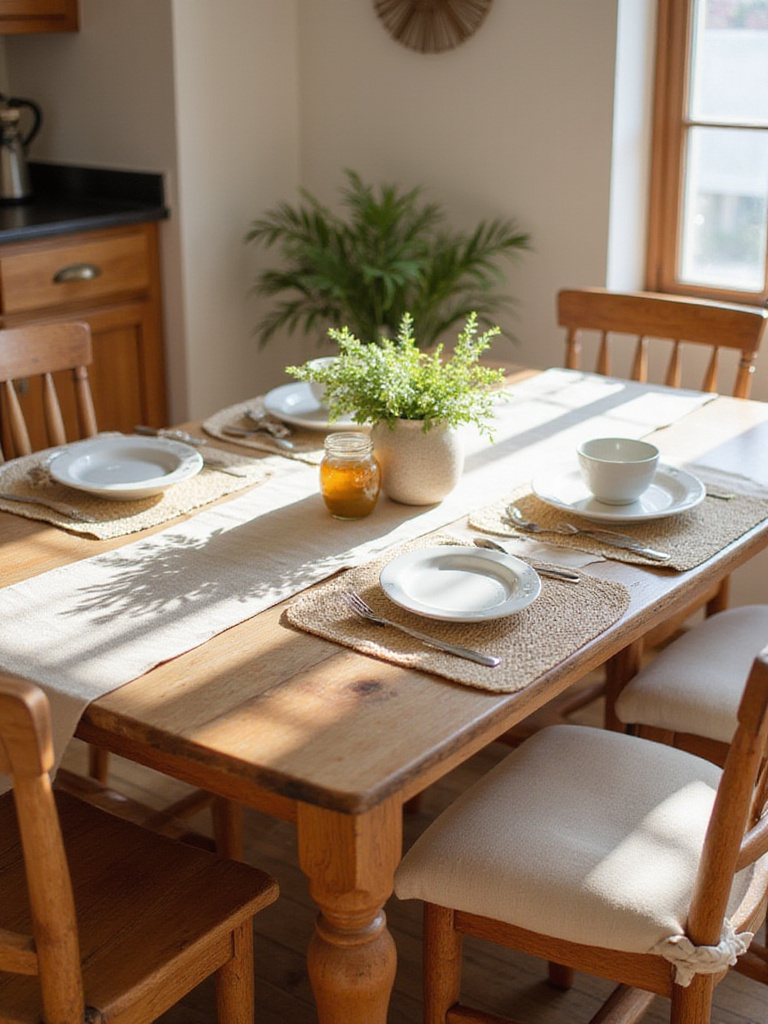
Establish protective habits that become second nature. Use placemats, coasters, and trivets religiously to create barriers between your table and potential damage sources. Keep a supply of absorbent cloths nearby for immediate spill cleanup—moisture left sitting on wood can penetrate even good finishes and create permanent stains or white marks. For activities like crafting or homework, use dedicated protective mats that cover the entire work area.
Consider more comprehensive protection for intensive use periods. Custom-cut glass tops provide maximum protection while allowing the wood’s beauty to show through. Table pads offer cushioned protection that’s ideal for families with young children. For temporary heavy-duty protection during messy projects, use disposable paper or plastic coverings over your regular protective layers. The key is making protection convenient enough that you’ll actually use it consistently rather than occasionally.
The quality becomes evident after years of use when proper maintenance keeps your table looking beautiful and functioning perfectly.
17. Properly Clean and Maintain Your Table’s Wood Finish
Consistent maintenance preserves your farmhouse kitchen table’s beauty and extends its functional life significantly. In small spaces where this piece likely sees daily use for multiple purposes, proper care prevents the gradual degradation that turns a beautiful centerpiece into a worn-out surface requiring expensive refinishing.
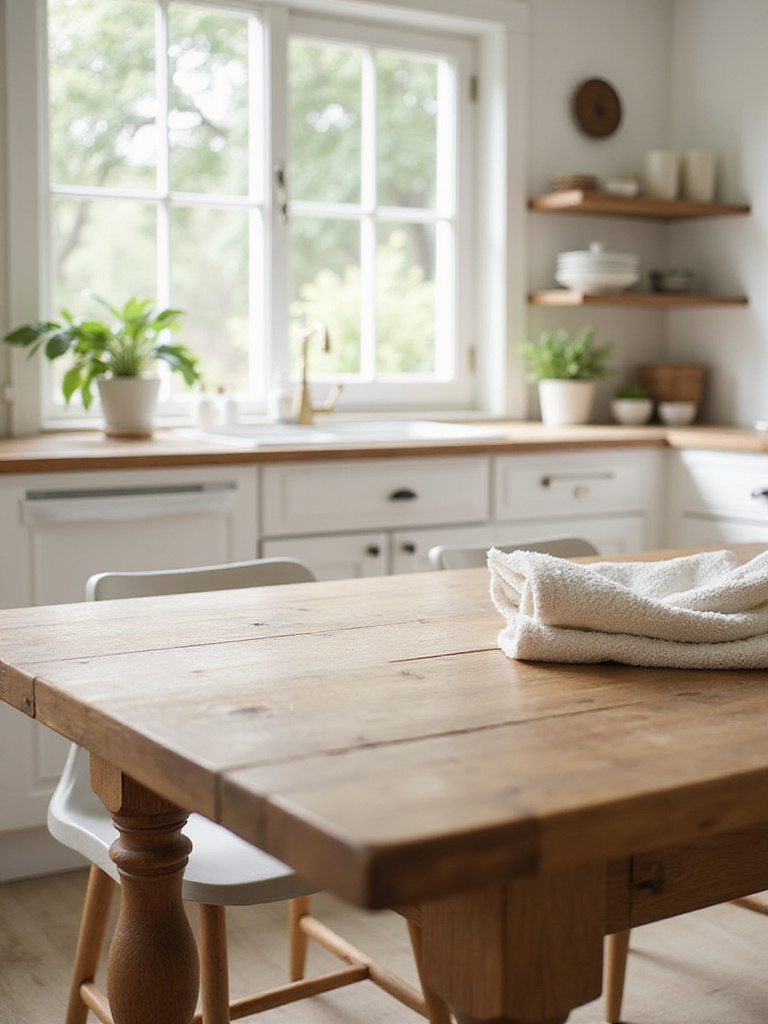
Develop a simple daily routine that takes minutes but provides lasting protection. Dust regularly with microfiber cloths to remove abrasive particles that can scratch the finish over time. Address spills immediately by blotting—never rubbing—with absorbent cloths to prevent moisture penetration. For sticky residues, use a barely damp cloth with mild dish soap, followed immediately by thorough drying to prevent water damage.
Monthly deeper cleaning maintains the finish’s protective properties. Use wood-specific cleaners or polishes appropriate for your table’s finish, applying sparingly and buffing thoroughly. Avoid all-purpose cleaners, which can break down wood finishes, and never use excessive water or harsh chemicals. Reapply protective finishes as recommended by the manufacturer—typically every 1-2 years for heavily used surfaces. This proactive approach maintains both appearance and protection, preventing the need for costly refinishing projects.
The finishing touch that elevates the entire look involves styling your table with thoughtful accessories that reflect your personal aesthetic.
18. Style Your Farmhouse Table with Runners and Decor
Thoughtful styling transforms your farmhouse kitchen table from a functional surface into a curated focal point that reflects your personality while providing additional surface protection. In small spaces where every design element needs to work harder, your table’s styling should enhance both form and function without creating clutter or impeding daily use.
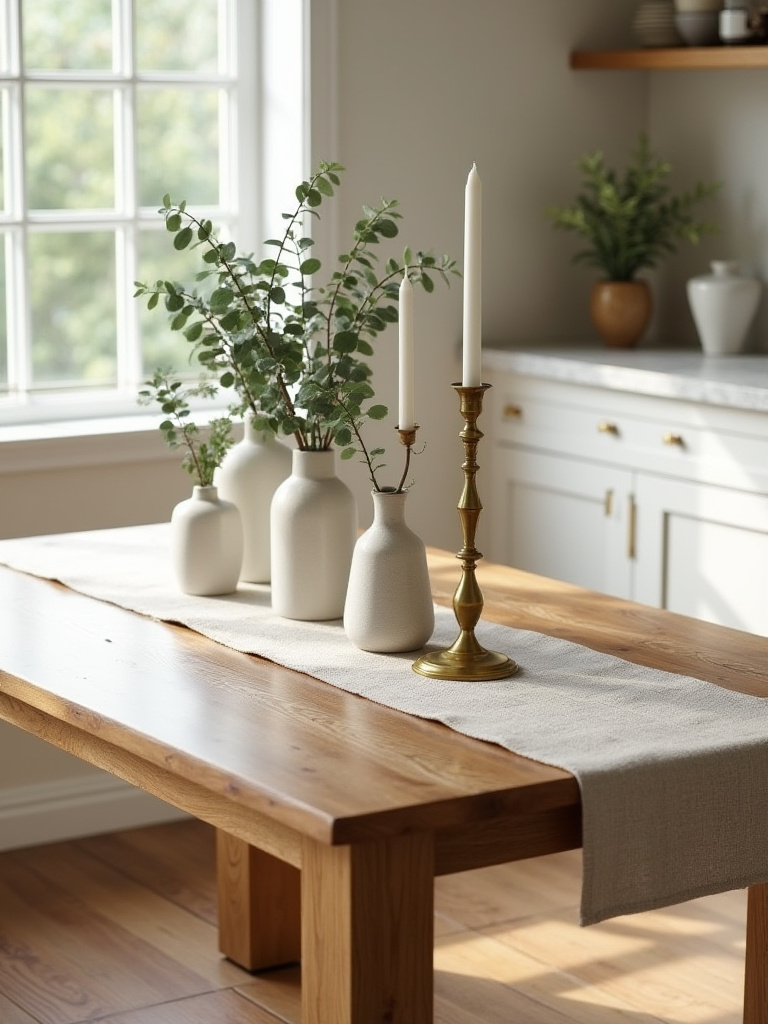
Choose table runners and placemats that complement your space’s scale and color palette. In compact kitchens, avoid overwhelming patterns or overly large accessories that make the space feel busy. Natural materials like linen, cotton, or jute reinforce farmhouse aesthetics while providing practical protection. Layer textures thoughtfully—a smooth ceramic vase on a textured runner, or rough-hewn wooden bowls on sleek placemats—to create visual interest without chaos.
Keep centerpieces proportional to your table and functional needs. A collection of varying-height candles, a simple wooden bowl filled with seasonal items, or a small potted herb garden can provide beauty without interfering with daily activities. Rotate accessories seasonally to keep the look fresh without requiring major investments. Remember that in small spaces, less is often more—choose a few impactful pieces rather than many small items that can make your table feel cluttered and reduce its functionality for daily tasks.
Conclusion
Your farmhouse kitchen table represents far more than a piece of furniture—it’s the foundation for daily life in your small space, serving as dining surface, workspace, homework station, and gathering place all in one. By applying these 18 essential strategies, you’re equipped to choose, style, and maintain a table that maximizes both function and beauty in your compact home.
The key to success lies in understanding that every decision, from budget and size to materials and maintenance, should reflect the unique demands of small-space living. Your table needs to work harder than its counterparts in larger homes, serving multiple functions while maintaining the warm, welcoming character that makes farmhouse style so appealing. Whether you invest in a new piece, discover a secondhand treasure, or transform an existing table through refinishing, the principles remain the same: prioritize quality construction, choose appropriate size and materials, and maintain it properly to ensure years of reliable service.
Remember that your farmhouse kitchen table is an investment in your home’s functionality and your family’s daily comfort. Take the time to make thoughtful choices, protect your investment through proper care, and style it in ways that reflect your personality while supporting your lifestyle. With the right approach, your table will serve as the hardworking heart of your small space for years to come, proving that great design and practical function can coexist beautifully in any size home.
